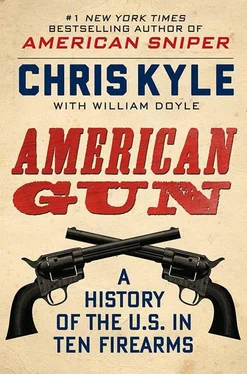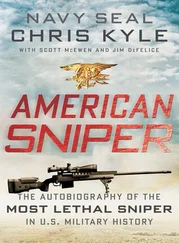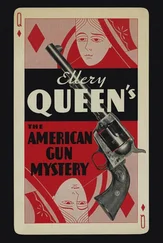Assault rifles, which we’ll define as rifles that can be selected to fire single shots, bursts, or full automatic, had been around for more than twenty years. The Germans used a number of early versions, including the FG42 and the StG44 or MO-44. “StG” stood for “Sturmgewehr” or “storm gun,” which is how we got the term “assault rifle.” The weapon could fire five hundred rounds a minute but weighed only eleven and a quarter pounds empty. It used 7.92 × 33mm Kurz ammo fed from a 30-round magazine.
The StG44 appeared way too late to make any difference in the war. But it did influence the development of a weapon that today remains a classic: the AK47. Designed by Mikhail Kalashnikov in the Soviet Union in the early postwar years, the AK was—and is—a rugged, dependable gun that’s cheap, easy to use, and no problem to maintain.
By the time World War II ended, the U.S. Army was working on its own automatic weapon. The most promising models were offspring of the M1. As we’ve said, these led to the M14, which despite its other qualities turned out to be less than the best choice for an assault rifle.
Among the roads not traveled by the brain trust at the Ordnance Department and the Springfield Armory was an odd little gun that some called “the aluminum rifle.” That’s because the weapon had an aluminum barrel with a steel liner. Instead of wood, the stock was made of fiberglass and foam. From the outside, the rifle looked about like any other .308 hunting gun. Pick it up, though, and you were in for a shock—it weighed six pounds, and that was with the scope.
The gun was an AR-1, made by a tiny division of Fairchild Engine and Airplane Corporation called ArmaLite located in of all places Hollywood, California. Only a handful of the prototypes were made, but you’ve got to start somewhere. That design helped convince Fairchild to give ArmaLite enough funding to get down to serious weapons design.
The company’s first big weapon was a little one—the AR-5 survival rifle, bought by the Air Force and designated the MA-1 Survival rifle. This was a .22-caliber peashooter meant to be carried by aircrews and used in desperation—great desperation—if shot down. It wasn’t designed to kill enemy soldiers, though it could have been used for that if necessary. The MA-1 was more your basic varmint gun, good for rabbits, beer cans, and not much more.
The theme running through ArmaLite’s early work was their willingness to work outside the box—far outside. Lightweight guns? Guns made with aluminum or fiberglass? A .22 in a warrior’s hands? All novel ideas.
But being different doesn’t get you anywhere on its own. You also have to be good. And ArmaLite really didn’t arrive at that point until it hired, almost by chance, Eugene Stoner. The self-taught gun maker was an amateur in the best sense of the word—he loved the art of making weapons, and he devoted himself to it. It became a very productive relationship.
One of its earliest results was the AR-10, a seven-pound automatic rifle that fired NATO 7.62 × 51mm rounds. The AR-10 had a pistol grip and a carrying handle. Its receiver was made of aluminum and its stock from phenol formaldehyde resins—another of those fancy words for something most of us call plastic.
If it sounds like I’m describing the M16, I am, pretty much, except for the rifle rounds.
The AR-10 was a unique gun. It was good, but it wasn’t a perfect design. The barrel overheated, and there were a number of other nits and nags that would’ve had to be corrected before the gun went into production. But even if it had been perfect, the powers-that-were in the Army had pretty much already settled on what they wanted: the M14. In 1955, the Stoner ArmaLite contribution was shoved aside.
But not forgotten.
Pushed by Colonel Henry Nielsen, the head of the Army’s Infantry Board, and General Willard Wyman, ArmaLite went to work on a version of the gun that used a smaller cartridge. The thinking was that a lot of smaller rounds would be more lethal in combat than fewer larger rounds.
One of the main points in the argument, which raged through the military and civilian think tanks, was how much ammo a rifleman could carry into battle. Would 650 smaller bullets trump 220 larger cartridges? If most battles are fought at 100 yards, does every rifleman need a gun that can fire twenty times that far? If a small bullet can be made to do more damage than a larger one at combat range, which is better? And if most soldiers are crappy shots when the you-know-what hits the fan, isn’t it better to increase their odds by giving them more chances to hit something every time they press the trigger?
The gun Stoner and ArmaLite produced was the AR-15. Its rounds were 5.56 × 45mm—which frankly sounds a heck of a lot more deadly than .22, which is what they were—Stoner used a .223 variant of Remington .222, the same round a lot of farmers favored to get rid of prairie dogs.
The AR-15 was ready for Army testing in 1957. You already know that it lost out to the M14. By then, Fairchild gave up arguing with the Army about the AR-15 and sold the weapon in 1959 to Colt’s Patent Firearms Manufacturing Company for $75,000, and 4.5 percent royalties on any future units sold. The price was a bargain.
ArmaLite was spun off from its parent company. It’s still in business making guns today. Colt, meanwhile, started showing the AR-15 around to potential buyers. Most people think the U.S. Air Force doesn’t have much call for rifles. And it’s true pilots aren’t going to pop their canopy at Mach 2 and take shots with a rifle. But the service does have a need for security at its bases, and after trying the AR-15 in 1960, Air Force vice chief of staff Curtis LeMay wanted it for his troops. LeMay didn’t get them until he was promoted to chief of staff, and even then had to deal with a lot of politics to receive his order of 8,500 placed. But he got them.
Army Special Forces also wanted the rifles; regular Army generals sought to keep M14s. Arguments went back and forth debating the pluses and minuses, until finally in 1963, Defense Secretary Robert McNamara put the M14 on hold and placed an order for more than 100,000 AR-15s, soon to be known as the M16.
The M16 had several advantages over the M14. It was much easier to control in full-auto. In fact, it was easy to operate overall. It was light as a feather by automatic weapons’ standards—barely nine pounds with a full mag. It wasn’t as long and heavy as the M14, and it had a lighter recoil, kind of like a gentle push when compared to the hard kick of the original M14. It was pretty accurate up to 460 meters. It was ideal for soldiers with small body builds, like our South Vietnamese allies. Its smaller rounds meant you could carry more. It even had the unique potential to make Pentagon bean counters happy, because it was relatively cheap and easy to produce.
The XM16E1 and the variations that followed all operate basically the same way. Loading is easy enough—slip the mag up into the receiver until you hear and feel a click. Pull back the charging handle and let go to chamber a round. You’re good to fire.
Fire rate—single and auto, or single and three-round burst, depending on the model—is set by a switch on the left side above the trigger.
The gun was designed to lessen the effect of recoil. There are stories about trainers showing off the smooth-firing weapon for green recruits by putting the M16’s butt in their crotch while firing.
Colonel Moore jumped from the helicopter and ran across a deep, dry creek bed at Ia Drang. The rest of his command group trotted behind. Though the Americans occasionally fired into the nearby brush, so far they had not drawn enemy fire. Moore found a spot between some giant anthills, and set up his command post.
Читать дальше












